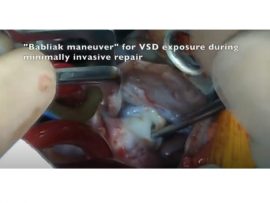Abstract Surgical research has shifted from the laboratory focus of the mid to late 20th century to a more mixed economy of data science, collaborative and qualitative research, with a..
Read MoreAbstract Background The optimal strategy for cerebral protection during repair of type A acute has yet to be determined. We sought to determine the impact of differing degrees of hypothermia in..
Read MoreAbstract The objective of clinical research is to establish ethically and methodologically sound evidence that can aid clinical decision-making, inform ongoing research and add to the existing body of knowledge...
Read MoreAbstract BACKGROUND Patients with three-vessel coronary artery disease have been found to have better outcomes with coronary-artery bypass grafting (CABG) than with percutaneous coronary intervention (PCI), but studies in which..
Read MoreAbstract Background: Acute kidney injury (AKI) is associated with high morbidity and mortality; therefore, prevention is important. The aim of this study was to systematically assess AKI incidence after cardiac surgery..
Read MoreAbstract Anesthesiologists are important components of volunteer teams which perform congenital cardiac surgery in low-resource settings throughout the world, but limited data exist to characterize the nature and breadth of..
Read MoreAbstract Perioperative myocardial infarction is a serious complication affecting a significant portion of patients undergoing coronary artery bypass graft surgery. This may arise due to coronary graft thrombosis, a rare..
Read MorePatient with very very low LVEF and severe MR in TEE and TTE as you can see just with SVR surgical ventricular restoration and CABG MR completely reduced as you..
Read MoreOften we come upon pauses on 12-lead ECGs and rhythm strips. Some of these pauses have durations that we are simply unable to justify while others are easier to comprehend...
Read MoreEducational video. The less traumatic and best cosmetic approach for children with congenital heart defects is Right Axillary Mini-Thoracotomy. The problem with complex defects repair through the Right Axillary MIni..
Read MoreIn the last years, new trends on patient diagnosis for admission in cardiac intensive care unit (CICU) have been observed, shifting from acute myocardial infarction or acute heart failure to..
Read MoreAbstract Background: The decision about whether to use venoarterial extracorporeal membrane oxygenation (VA-ECMO) in patients with cardiac graft dysfunction (GD) is usually made on a case-by-case basis and is guided by..
Read MoreAbstract Introduction and objectives Lactate and its evolution are associated with the prognosis of patients in shock, although there is little evidence in those assisted with an extracorporeal venoarterial oxygenation..
Read MoreAbstract Background Age over 70 years seems to confer poor prognosis for patients under mechanical circulatory support (MCS). Advanced age is usually a relative contraindication. Our objective was to assess the..
Read MoreCABG in patient with cancer Head of pancreas as well as Portal vein thrombosis in these cases on important issue regarding CPB is the usage of bicaval instead of two..
Read MoreSevere tricuspid valve regurgitation secondary to Ebstein’s anomaly represents several challenges in neonates. It can result in significant respiratory and/or hemodynamic compromise that mandates urgent interventions. When conservative management fails,..
Read MoreAbstract Stroke has potentially devastating consequences for patients receiving veno-arterial extracorporeal membrane support (VA-ECMO). Arterial cannulation sites for VA-ECMO include the ascending aorta, axillary artery, and femoral artery. However, the..
Read MoreAbstract Background The VentriFlo® True Pulse Pump (VentriFlo, Inc, Pelham, NH, USA) is a new pulsatile blood pump intended for use during short-term circulatory support. The purpose of this study was..
Read MoreAbstract Rapid reductions in PaCO2 during extracorporeal membrane oxygenation (ECMO) are associated with poor neurologic outcomes. Understanding what factors determine PaCO2 may allow a gradual reduction, potentially improving neurologic outcome. A simple..
Read MoreAbstract Cardiogenic shock is an uncommon but serious complication of acute myocardial infarction. Temporary mechanical circulatory support devices are being used more often in this setting, and physicians are required..
Read MoreAbstract OBJECTIVES: Patients in the pediatric cardiac ICU are frequently exposed to pharmacologic and environmental factors that predispose them to sleep disturbances and may increase the risk of delirium. In..
Read MoreAbstract Surgical time-outs are designed to promote situation awareness, teamwork, and error prevention. The pre-incision time-out in particular aims to facilitate shared mental models prior to incision. Objective, unbiased measures..
Read MoreAbstract The level of evidence of expert recommendations for starting extracorporeal cardiopulmonary resuscitation (ECPR) in refractory out-of-hospital cardiac arrest (OHCA) and in-hospital cardiac arrest (IHCA) is low. Therefore, we reported..
Read MoreAbstract Drugs intoxications often lead to severe vasoplegia and cardiogenic shock, and VA-ECMO represents a viable therapy option. However, as cardiopulmonary support is not contributing to the removal of the..
Read MoreAbstract Background SBP and DBP have important associations with cardiovascular events, but are seldom considered simultaneously. Objectives This study sought to simultaneously analyze systolic blood pressure (SBP) and diastolic blood..
Read MoreAbstract Purpose Patients with (ECLS) are at risk for hemolysis-related complications. Therefore, monitoring of free hemoglobin (fHb) levels is indicated. Conventional methods for fHb are laborious and not always available. Here..
Read MoreAbstract Newswise — November 22, 2021 – – with no increased risk of transmitting COVID-19 transmission to ECMO transport team members following standard precautions, reports a study in the , official journal of..
Read MoreA 60-year-old female was admitted to the Emergency Department after she was found unconscious by her husband. [pdf-embedder url="https://perfusfind.com/wp-content/uploads/2021/10/CoW_47_2021_E_web_compressed.pdf"]
Read MoreAbstract Background Whether perioperative glycemic control is associated with neurocognitive decline (NCD) after cardiac surgery was examined. Methods Thirty patients undergoing cardiac surgery utilizing cardiopulmonary bypass (CPB) were screened for..
Read More




















